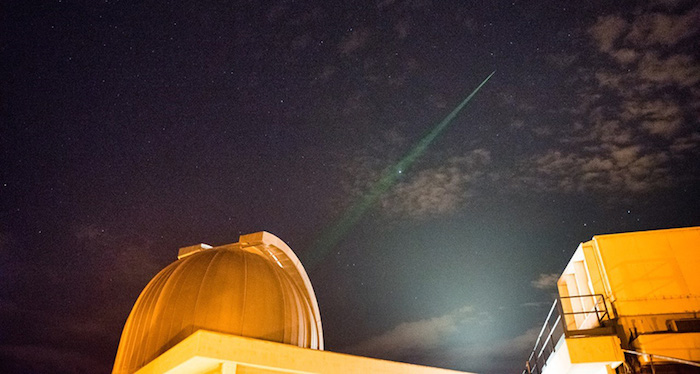.
Quantum weirdness survives space travel
Photons sent to satellite and back maintain cryptography ability
.

QUANTUM MESSAGES Scientists used a telescope (shown) to direct photons to satellites and then measure the photons’ quantum properties on their return. The green laser visible in the image is used to track the location of the satellite. The scheme shows that quantum communication in space may be technologically feasible.
In a feat that demonstrates the feasibility of using satellites to transmit uncrackable quantum messages, scientists have measured the quantum properties of photons sent to space and back again.
Physicists beamed the blips of light up to a satellite that reflected them back to Earth. Upon the photons’ return, the team, led by Paolo Villoresi of the University of Padua in Italy, observed a property known as quantum interference. That confirmed that the particles’ quantum traits remained intact over the 5,000-kilometer space voyage. The team reports the advance in a paper to be published in Physical Review Letters.
The technique could one day lead to quantum cryptography by satellite,allowing users to send snoop-proof encryption keys for encoding secret information. “It’s important for the sake of secure communication and advancement of physics,” says Villoresi. But that’s not the only reason he took on the challenge. “I can more honestly say that it’s cool.”
Quantum interference is a fact of life for tiny particles like photons. Just as ripples in a pond can interfere with one another, increasing or decreasing in height as they collide, quantum particles — which have wavelike properties — can interfere with themselves (SN Online: 9/15/14). This interference amplifies or diminishes the probability that a particle will appear at a particular time or place.
To produce the quantum interference, the scientists first split photons in two — a feat that is possible because quantum mechanical particles can be in two places at once, a state known as a superposition. The scientists sent light pulses through an optical apparatus, designed so that each photon traversed two paths simultaneously before recombining at the other side. But because one of the paths was longer than the other, when a photon came out the other end, it was split into two packets, one lagging a few billionths of a second behind the other. Such a state is known as a temporal superposition.
A satellite-tracking telescope, located at the Matera Laser Ranging Observatory in Italy, then beamed the photons up to an orbiting satellite equipped with reflectors that bounced the photons back in the direction they came from. The photons returned to the telescope and traveled back through the optical setup into a detector. Due to quantum interference, the distribution of the photons’ arrival times differed from that expected in the nonquantum case. And the amount of interference varied depending on the velocity of the satellite — in agreement with scientists’ predictions.
“It’s quite challenging to make these links between a satellite and Earth station,” says physicist Hugo Zbinden of the University of Geneva, who was not involved with the research. Scientists have previously transmitted photons’ quantum properties via satellite, but those photons were in polarization superpositions — the photons’ electric fields were oriented in two directions at once. Temporal superpositions have some advantages over polarization superpositions. For instance, the polarization might be lost when the photon bounces off the satellite, Zbinden says.
The new result indicates that quantum communication can work outside of pristine laboratory environments. “Whether this could survive such long distances and harsh experimental conditions, that was a big question,” saysphysicist Alexander Sergienko of Boston University. “Everybody else is doing this either in the lab or kind of in a quiet environment somewhere.”
Quelle: ScienceNews
4551 Views
